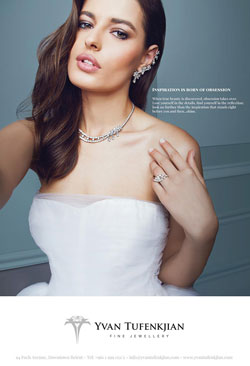FANCY COLORED DIAMONDS
Diamonds are found in almost every color of the spectrum, but the majority of diamonds will have tints of yellow or brown.
Brown and yellow diamonds that exhibit more color than the Z grade within the D-Z color scale are known as fancy colors. Since most diamonds have a bit of yellow or brown, any other colors outside of those hues are called fancy colors. This includes pink, blue, green, black, red, and orange diamonds.
DIAMOND COLOR SCALE
Diamonds are generally evaluated by a diamond color scale that was developed in the 1950s by GIA's Richard T. Liddicoat. The Color Grading Scale starts with the letter D and ends at Z.
D colored diamonds have the least amount of color and Z colored diamonds have the most color in the range of D-Z. Beyond Z color, diamonds are graded as Fancy Color with a separate set of parameters.
HOW ARE FANCY COLORS GRADED?
Laboratory graders assess fancy color diamonds from the face-up or top view of the diamond.
Graders evaluate the hue, tone, and saturation of each diamond.
Hue - A diamond's overall body color
Tone - A diamond's lightness or darkness in relation to body color
Saturation - The intensity or degree of color
Secondary or modifying colors are also assessed, as they impact the overall hue of the fancy color:
A yellow diamond may have a green secondary, and will subsequently be graded as "Fancy Greenish Yellow."
GRADING TERMS
Faint. Very Light, Light, Fancy Light
Fancy, Fancy Intense, Fancy Dark, Fancy Deep, Fancy Vivid
SOURCES
Fancy color diamonds are found in Australia, Canada, Brazil, and throughout Africa. Pink diamonds are most commonly found at the Argyle mine in Australia, but pink, yellow, blue, and even green diamonds have also been found in the alluvial deposits of Northwest Africa.
|
|
WHAT CAUSES COLOR IN DIAMONDS?
Trace elements, structural irregularities, and radiation
• Yellow Diamonds: Presence of nitrogen.
• Brown, Pink, and Red Diamonds: Colored graining, which results from structural irregularities in the crystal lattice.
• Blue Diamonds: Presence of boron with possible presence of hydrogen.
• Green Diamonds: Natural radiation.
• Grey and Violet Diamonds: Most likely the presence of hydrogen (grey diamonds are known for high amounts of hydrogen, while violet diamonds are still being studied for exact cause of color).
• Black Diamonds: Dark inclusions or impurities, which are great in number and evenly distributed throughout a diamond.
• Orange Diamonds: Structural irregularities in combination with the presence of trace elements like nitrogen, though exact cause of color is still being studied.
VALUE
• Hue, tone and saturation along with rarity and popularity of color affect fancy color diamond pricing.
• The more rich and saturated the color, the higher the value.
• Fancy color diamonds that are true to hue with vivid coloration will be priced higher than lighter and less saturated stones.
• Pure red diamonds command the highest prices per carat worldwide.
• Fine yellow, pink, blue and green diamonds garner high prices depending on quality and size.
• Brown diamonds are generally the least expensive of natural fancy colors. As with colored stones in general, color is paramount for fancy color diamond pricing.
• Clarity and cut do not affect prices as much as with colorless diamonds.
CUT
Unlike colorless diamonds, fancy color diamonds are cut to maximize color. The deeper the pavilion (bottom half of a diamond) the more color is returned to the eye.
Be aware of TREATMENTS
• Irradiation: Common colors for diamonds treated by irradiation include green and greenish blue.
• Irradiation plus heating (annealing): Annealing is the process of heating and cooling a diamond. It is used in combination with irradiation to create red, pink, purple, orange, yellow, brown and black colors.
• High Pressure High Temperature (HPHT): HPHT is a process used to change the color of certain types of diamonds. HPHT treatment can be detected by a gemological lab.
|
|
www.yvantufenkjian.com

|